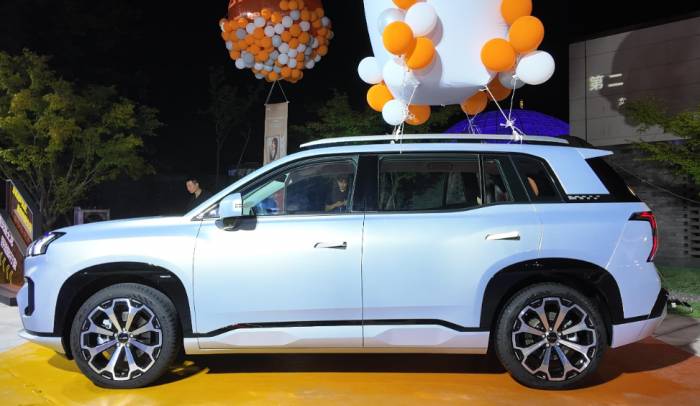The second generation Aion V was launched and it was sold wildly. The configurat
tech | 2024-04-13
Chinese brand pure electric vehicle models that have been updated to the second generation are not many, and the transition from 1 to 2 signifies a leap in maturity. However, the path from 1 to 2 is not uniform. NIO's products have chosen to multiply their computing power, adopting an aggressive stance in technology; whereas the second-generation GAC Aion V does not employ an 800V architecture that is high-profile and aggressive, but maintains a full series of 400V—it opts for stability, not the extreme advancement, but rather strives to improve almost all aspects of design, space, comfort, and configuration that we encounter daily. So much so, that I can hardly find any dead spots in its cabin, and the choice of materials, the comfort of the seats, and the spaciousness of the rear seats are almost exaggeratedly impressive.
So when the second-generation Aion V finally set its price range at 129,800 to 189,800 yuan, even I, who is not usually sensitive to prices, felt the strong value for money. There is no reason for this generation of the Aion V "Tyrannosaurus Rex" not to sell well—now, the pressure is on the sales system.
The strength of the second-generation Aion V lies primarily in its positioning as a pure family-oriented large five-seater. Although the car is only in the 4.6-meter category in length, the exterior design is extremely square, and the roofline refuses to dip even slightly after the B-pillar, drawing a clear line between practicality and the more stylized designs of the Xiaomi SU7 and XPeng G6. Despite its pragmatism, the second-generation Aion V has still designed a strong personality of its own, adding a fierce "Tyrannosaurus Rex" temperament to the square shape, with headlights and taillights that are highly recognizable, and the high front and high rear window lines are not unattractive. The only minor drawback is that the charging port is located on the front fender, requiring the car to be positioned nose-first into the parking space when charging at an external charging station.
Advertisement
In terms of interior design, the standard symmetrical and neat layout has become its advantage in today's "chaotic sports and youthful" popular rhythm. With excellent choices of interior decorative materials and large areas of leather wrapping, it offers a visual class of 200,000 yuan level. The 14.6-inch central control screen, although not overly promoted in terms of vehicle machine marketing, feels smooth and has a decent software ecosystem after a brief experience. The default vehicle machine music software is QQ Music, which can appeal to young people. Personally, I encounter vehicle machines that, aside from the default QQ Music and NetEase Cloud Music apps, require connecting via Bluetooth to play music from a smartphone.
The armrest features a design with two cup holders and two reclining phone slots, with storage performance being average. It can accommodate a small refrigerator with a minimum temperature of -15 degrees Celsius, which is quite a test of engineering difficulty.The seat upholstery is comfortable, and the overall thickness and volume are quite substantial, ensuring the rationality and comfort of the frame. The Aion brand still inherits the essence of car manufacturing from GAC, which is more favored by experienced drivers compared to Zero Run at a similar price point.
The comfort of the rear seats has been further improved. Not only is there ample legroom for someone who is 173cm tall, with a space of up to two and a half fists, but the seats are also very wide horizontally. The center position is flat and the shock absorption layer is thick, which is a genuine optimization for the fifth passenger, making it extremely friendly for families with three members and two elderly people who often travel together. The second-row seatbacks also support a large angle recline, which is very helpful in alleviating fatigue from long-distance travel.
In terms of power, this time there are two single-motor configurations available, with maximum power of 150kW and 165kW, both corresponding to a peak torque of 240N·m. Although it can provide a zero-to-hundred acceleration of 7.9 seconds for the entire series, I still think this level of power is just enough. The absence of dual-motor models and 800V architecture is also the reason why the overall price range ceiling is not high this time.
However, the low point is not low either. Even though it is a 400V model, the standard charging power has reached 180kW, which is close to the 230kW of some models that are on the edge of 800V. In addition, GAC Aion also has its own built-in charging resources. The second-generation Aion V series will provide the first owner with a 1500-degree charging quota for the first year. In terms of energy replenishment, the experience is still better than that of the new energy sales king brand in Guangdong.Additionally, the second-generation Aion V offers three endurance versions to choose from, which are 520km, 650km, and 750km under the CLTC pure electric range standards. Among them, the 750km version is priced at 179,800 yuan, making it a very suitable choice for families who enjoy self-driving tours and often need to travel between cities. The top-of-the-line model comes with a 650km range, equipped with LiDAR and the Orin X chip, supporting map-less NOA (Navigation on Autopilot), which is expected to attract some young consumers and tech-savvy middle-aged men.

Overall, the second-generation Aion V has a low starting price and a reasonable top-end price, which is a pragmatic pricing strategy on top of a practical product in the current competitive car-selling environment. Personally, I am quite optimistic about its sales prospects.
Comments